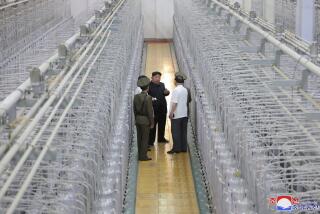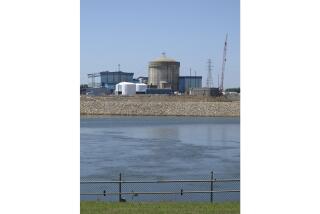Leak at S. Korean Plant Exposes 22 to Radiation
- Share via
TOKYO — Twenty-two workers at a South Korean nuclear plant have suffered what appeared to be minor levels of radiation exposure in the second nuclear accident within less than a week in Asia, the government said.
Though apparently far less serious than Japan’s potentially lethal nuclear accident just four days earlier, the event this week nevertheless brought renewed calls for greater nuclear safety in Asia, where the nuclear power industry is still rapidly expanding and many are nervous about the potential for similar disasters.
The workers, mostly employees of Korea Electric Power Corp., which operates the plant, were exposed to small amounts of radiation Monday when radioactive water leaked inside the Wolsung reactor, 190 miles southeast of Seoul. The incident was not reported to the government by the utility until a day later, triggering a reprimand from regulators.
Four dozen people were injured Thursday in Tokaimura, Japan, when employees loading highly enriched uranium at a nuclear fuel processing plant triggered a fission reaction in a facility not designed to handle one. Radiation leaked at levels 4,000 times higher than normal outside the plant.
Based on information reported to South Korean regulators, no radiation from Wolsung leaked outside the reactor during Monday’s incident, in which the reactor was not operating while maintenance was performed. The government said about 12 gallons of so-called heavy water leaked inside the building.
“It did not leak outside the building. It did not affect the environment,” the Science and Technology Ministry said.
Heavy water looks like ordinary water but contains different forms of hydrogen. It can become radioactive by absorbing tiny amounts of radioactive metal as it circulates inside reactor pipes.
“If it hadn’t been for the accident in Japan, nobody probably would have heard of it,” said Anthony Baratta, a professor of nuclear engineering at Pennsylvania State University and a nuclear-accident analyst who said that the leak wouldn’t cause substantial hazards.
“Such leaks happen every two to three years in the U.S.,” he said.
The doses of radiation workers received were many orders of magnitude below those that victims suffered in Japan. According to the figures the utility provided to the Science and Technology Ministry, the power plant workers suffered radiation levels from below .006 millisievert, less than a chest X-ray, to 4.5 millisieverts, which is one-tenth the annual level at which exposure is considered dangerous.
“It’s undesirable, but it’s not anything catastrophic,” Baratta said.
One sievert is equivalent to 100 rem. It is a measurement of potential radiation damage to living organisms.
No one was treated or hospitalized by the company. Hence, the Science and Technology Ministry was planning to do its own independent analysis.
But Shaun Burnie, director of the East Asian nuclear program at the environmental group Greenpeace International, said South Korean safety regulations have not kept pace with the country’s rapid nuclear power expansion. The country went from having no nuclear power in the 1970s to having 14 major power plants that provide about 40% of its power.
“Korean safety standards make Japan’s look par excellence,” Burnie said.
The Korea Electric Power Corp. reactors in Wolsung have had three larger-scale accidents involving the leakage of irradiated heavy water: 23.5 tons released in 1984, 6.5 tons in 1994 and 500 pounds in 1995.
On the safety issue, operations at reactors nationwide were temporarily suspended 11 times in 1998 for up to two weeks for malfunctions and safety violations.
More to Read
Sign up for Essential California
The most important California stories and recommendations in your inbox every morning.
You may occasionally receive promotional content from the Los Angeles Times.










